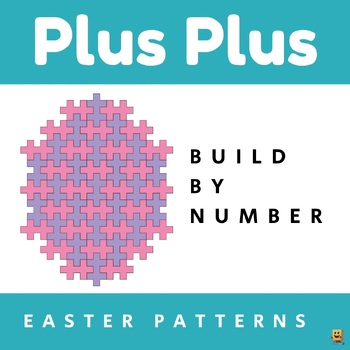Easter activity for Plus Plus blocks / Prek & Kindergarten Math Center activity
ICanBuild
27 Followers
Resource Type
Standards
CCSSK.CC.A.2
CCSSK.CC.A.3
CCSSK.CC.B.4
CCSSK.CC.B.4a
CCSSMP1
Formats Included
- PDF
ICanBuild
27 Followers
Also included in
- A huge Bundle of Seasonal Holiday activities for Plus Plus blocks, including Spring, Easter & St Patrick’s Day. Perfect for a Kindergarten morning bin, Maker Station, STEM or Math Center. Includes 2D Task Cards, Unique Designs for each holiday. Great for all ages. Task cards show each design aPrice $15.00Original Price $20.05Save $5.05
Description
Are you looking for an Easter activity to use with Plus Plus blocks ? Kids will love this number recognition math center activity. Developing fine motor skills as they build Patterns. Designed for both Big Plus Plus blocks & regular. Suitable for Prek, Kindergarten, Grade 1 2
The Details
- Includes 8 Designs
- 8 Small Pattern mats for regular size plus plus blocks
- 8 Big Plus Plus Pattern mats for Big Plus Plus blocks.
- Different levels of challenge so they are suitable for PreK - Grade 3
- Easy low prep. Print, laminate if you wish. Stick the Large Mats together with. Tape. Easy peazy.
- Helps children develop pattern awareness, sequencing & number recognition
- Strengthens Fine motor skills
- Boosts creativity
Follow my store Click here
Want another Easter activity?
Total Pages
Answer Key
N/A
Teaching Duration
N/A
Last updated 3 months ago
Report this resource to TPT
Reported resources will be reviewed by our team. Report this resource to let us know if this resource violates TPT’s content guidelines.
Standards
to see state-specific standards (only available in the US).
CCSSK.CC.A.2
Count forward beginning from a given number within the known sequence (instead of having to begin at 1).
CCSSK.CC.A.3
Write numbers from 0 to 20. Represent a number of objects with a written numeral 0-20 (with 0 representing a count of no objects).
CCSSK.CC.B.4
Understand the relationship between numbers and quantities; connect counting to cardinality.
CCSSK.CC.B.4a
When counting objects, say the number names in the standard order, pairing each object with one and only one number name and each number name with one and only one object.
CCSSMP1
Make sense of problems and persevere in solving them. Mathematically proficient students start by explaining to themselves the meaning of a problem and looking for entry points to its solution. They analyze givens, constraints, relationships, and goals. They make conjectures about the form and meaning of the solution and plan a solution pathway rather than simply jumping into a solution attempt. They consider analogous problems, and try special cases and simpler forms of the original problem in order to gain insight into its solution. They monitor and evaluate their progress and change course if necessary. Older students might, depending on the context of the problem, transform algebraic expressions or change the viewing window on their graphing calculator to get the information they need. Mathematically proficient students can explain correspondences between equations, verbal descriptions, tables, and graphs or draw diagrams of important features and relationships, graph data, and search for regularity or trends. Younger students might rely on using concrete objects or pictures to help conceptualize and solve a problem. Mathematically proficient students check their answers to problems using a different method, and they continually ask themselves, "Does this make sense?" They can understand the approaches of others to solving complex problems and identify correspondences between different approaches.






